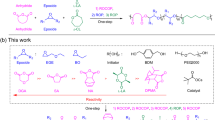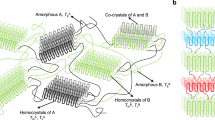Abstract
Defect-free and perfectly linear polyarylenebutadiynylenes can be readily synthesized through acetylenic oxidative polymerizations of diethynyl arene monomers. Although these polymers are ideal semiconducting polymers with a rigid main chain backbone, they often have solubility issues even with the introduction of alkyl side chain groups. We recently reported the synthesis of a poly(thieno[3,2-b]thiophen-2,5-diylbutadiynylene) derivative and its semicrystalline feature due to the limited solubility of this compound. To increase the processability of this polymer in solution, we utilized a Cu(I)-catalyzed azide-alkyne cycloaddition (CuAAC) click postfunctionalization to introduce polystyrenes into the polymer terminals. The molecular weights estimated from gel permeation chromatography (GPC) were reasonably increased, and the temperature-dependent absorption spectra suggested that the CuAAC-based functionalization was successful and furnished a coil-rod-coil type triblock copolymer. The resulting block copolymer exhibited higher solubilities in common organic solvents, but the electronic properties of the poly(thieno[3,2-b]thiophen-2,5-diylbutadiynelene) unit were retained in the solid thin film state.
This is a preview of subscription content, access via your institution
Access options
Subscribe to this journal
Receive 12 print issues and online access
$259.00 per year
only $21.58 per issue
Buy this article
- Purchase on Springer Link
- Instant access to full article PDF
Prices may be subject to local taxes which are calculated during checkout






Similar content being viewed by others
References
Zhao X, Zhan X. Electron transporting semiconducting polymers in organic electronics. Chem Soc Rev. 2011;40:3728–43.
Wang Y, Michinobu T. Benzothiadiazole and its π-extended, heteroannulated derivatives: useful acceptor building blocks for high-performance donor-acceptor polymers in organic electronics. J Mater Chem C. 2016;4:6200–14.
Osaka I, Takimiya K. Naphthobischalcogenadiazole conjugated polymers: emerging materials for organic electronics. Adv Mater. 2017;29:1605218.
Jiang Y, Pu K. Multimodal biophotonics of semiconducting polymer nanoparticles. Acc Chem Res. 2018;51:1840–9.
Wang Y, Michinobu T. Rational design strategies for electron-deficient semiconducting polymers in ambipolar/n-channel organic transistors and all-polymer solar cells. J Mater Chem C. 2018;6:10390–410.
Li Z, Chueh CC, Jen AKY. Recent advances in molecular design of functional conjugated polymers for high-performance polymer solar cells. Prog Polym Sci. 2019;99:101175.
Geng Y, Tang A, Tajima K, Zeng Q, Zhou E.Conjugated materials containing dithieno[3,2-b;2’,3’-d]pyrrole and its derivatives for organic and hybrid solar cell applications.J Mater Chem A. 2019;7:64–96.
Griggs S, Marks A, Bristow H, McCulloch I. n-Type organic semiconducting polymers: stability limitations, design considerations and applications. J Mater Chem C. 2021;9:8099–128.
Higashihara T. Strategic design and synthesis of p-conjugated polymer suitable as intrinsically stretchable semiconducting materials. Polym J. 2021;53:1061–71.
Chen J, Yang J, Guo Y, Liu Y. Acceptor modulation strategies for improving the electron transport in high-performance organic field-effect transistors. Adv Mater. 2022;34:2104325.
Yi Z, Wang S, Liu Y. Design of high-mobility diketopyrrolopyrrole-based π-conjugated copolymers for organic thin-film transistors. Adv Mater. 2015;27:3589–606.
Takimiya K, Nakano M, Sugino H, Osaka I. Design and elaboration of organic molecules for high field-effect-mobility semiconductors. Synth Met. 2016;217:68–78.
Fratini S, Nikolka M, Salleo A, Schweicher G, Sirringhaus H. Charge transport in high-mobility conjugated polymers and molecular semiconductors. Nat Mater. 2020;19:491–502.
Liu Q, Bottle SE, Sonar P. Developments of diketopyrrolopyrrole-dye-based organic semiconductors for a wide range of applications in electronics. Adv Mater. 2020;32:1903882.
Otep S, Ogita K, Yomogita N, Motai K, Wang Y, Tseng YC et al. Cross-linking of poly(arylenebutadiynylene)s and its effect on charge carrier mobilities in thin-film transistors. Macromolecules. 2021;54:4351–62.
Neumann S, Biewend M, Rana S, Binder WH. The CuAAC: principles, homogeneous and heterogeneous catalysts, and novel developments and applications. Macromol Rapid Commun. 2020;41:1900359.
Kim J, Jung HY, Park MJ. End-group chemistry and junction chemistry in polymer science: past, present, and future. Macromolecules. 2020;53:746–63.
Geng Z, Shin JJ, Xi Y, Hawker CJ. Click chemistry strategies for the accelerated synthesis of functional macromolecules. J Polym Sci. 2021;59:963–1042.
Tomita E, Kim K, Minegishi K, Nakamura A, Kanehashi S, Ogino K. Enhancement of out-of-plane hole mobility in poly(3-hexylthiophene)-b-poly(styrene) film. Macromol Chem Phys. 2018;219:1800186.
Hsu LC, Kobayashi S, Isono T, Chiang YC, Ree BJ, Satoh T et al. Hgihly stretchable semiconducting polymers for field-effect transistors through branched soft-hard-soft type triblock copolymers. Macromolecules. 2020;53:7496.
Miyanishi S, Zhang Y, Hashimoto K, Tajima K. Controlled synthesis of fullerene-attached poly(3-alkyolthiophene)-based copolymers for rational morphological design in polymer photovoltaic devices. Macromolecules. 2012;45:6424–37.
Higashihara T, Fukuta S, Ochiai Y, Sekine T, Chino K, Koganezawa T et al. Stretchable ABA triblock copolymer composed of poly(3-hexylthiophene) and polyisobutylene segments. ACS Appl Polym Mater. 2019;1:315–20.
Inagaki S, Higashihara T. Synthesis of an ABC triblock copolymer by a bilateral Click reaction using α,ω-bifunctionalized poly(3-hexylthiophene) as an inner segment. Polym Chem. 2022;13:3613–8.
Ishizuki K, Oka H, Aoki D, Goseki R, Otsuka H. Mechanochromic polymers that turn green upon the dissociation of diarylbibenzothiophenonyl: the missing piece toward rainbow mechanochromism. Chem Eur J. 2018;24:3170–3.
Kimpel J, Michinobu T. Conjugated polymers for functional applications: lifetime and performance of polymeric organic semiconductors in OFETs. Polym Int. 2021;70:367–73.
Chen X, Michinobu T. Post-polymerization modification: a powerful tool for the synthesis of stimuli-responsive polymers. Macromol Chem Phys. 2022;223:2100370.
Otep S, Tseng YC, Yomogita N, Chang JF, Chueh CC, Michinobu T. Coil-rod-coil triblock copolymers synthesized by macromolecular clicking and their compatibilizer effects in all-polymer solar cells. J Mater Chem C. 2022;10:346–59.
Acknowledgements
This work is supported by JSPS KAKENHI Grant 19H02786.
Author information
Authors and Affiliations
Corresponding author
Ethics declarations
Conflict of interest
The authors declare no competing interests.
Additional information
Publisher’s note Springer Nature remains neutral with regard to jurisdictional claims in published maps and institutional affiliations.
Supplementary information
Rights and permissions
Springer Nature or its licensor holds exclusive rights to this article under a publishing agreement with the author(s) or other rightsholder(s); author self-archiving of the accepted manuscript version of this article is solely governed by the terms of such publishing agreement and applicable law.
About this article
Cite this article
Ogita, K., Yomogita, N., Otep, S. et al. Facile access to coil-rod-coil-type block copolymers by CuAAC-based macromolecular clicking. Polym J 55, 427–432 (2023). https://doi.org/10.1038/s41428-022-00714-z
Received:
Revised:
Accepted:
Published:
Issue Date:
DOI: https://doi.org/10.1038/s41428-022-00714-z



